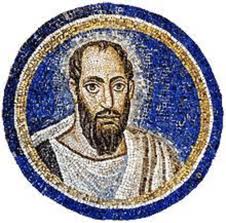

I have looked over many analyses of this letter but I have never seen a satisfactory one. For instance, I refer to C. T. Wood, Dean of Queen's College, Cambridge. His recent life of St. Paul shows a masterly command of all the most recent knowledge about Paul. He says that the doctrinal portions of the epistle are divided into three parts: (1) Justification; (2) Sanctification, and (3) Rejection by the Jews. This is no analysis at all if by an analysis we expect some indication of the structure of the epistle. Paul does not discuss justification in the first part of the epistle or in any other part. He scarcely uses the word. He does say that he has been justified, that is acquitted, which is one of the many pictures he gives of the change which has come over him, but to say that the epistle is a treatise on justification is entirely to miss its meaning. Wood gives no hint of the state in which Paul found himself and that is really the beginning of Paul's experience. I wonder under which head he would place Paul's cry, "Miserable man that I am, who will deliver me from the body of this death." And as for "Rejection by the Jews," that is no integral part of Paul's thought. The very problem to the mind of the modern man is, what possible relation can that conception have to the very real truth which Paul is obviously trying to impart.
Now let us turn to Richard Francis Weymouth, editor of "The Resultant Greek Testament" and author of the "New Testament in Modern Speech," a translation which I have found invaluable. He simply says that the heart of the gospel is Justification by Faith. That is a good formulation, particularly as it recognizes the fundamental unity of the epistle, but in no sense does it represent an analysis. It does not help us in making our way through the details of the epistle, and moreover he adds: "Justification by faith, mediated by the atoning death of Christ." Paul in fact never hints at the Atonement in this sense. But we shall come to that later.
One of the best-known authorities on Scripture at the present time is Benjamin W. Bacon, Professor of New Testament Exegesis in Yale Divinity School. He divides our epistle into two parts, a Doctrinal Section, and a Practical Section. The Doctrinal Section he analyzes as follows:
(1) God's conquest of Evil by Good in the Universe.
1. Justification
2. Sanctification
(2) God's working in Human History, The Choosing of Israel a Means of Redemption of all.
Here we have the same difficulty. Justification and Sanctification are emphasized again as structural parts of the epistle, although as subjects Paul does not discuss them at all. He does discuss Faith, but only in its functional aspects, not metaphysically. But what is worse, Bacon's analysis entirely divorces the so-called practical section from the essential structure of the essay. This I take to be misleading. There are not two parts, a doctrinal and a practical. It is all practical.
And so with any analysis we choose. Either it is so vague and general as to be meaningless, or if it constitutes in itself a real logically constructed outline, the chapters of the epistle as we read them simply will not follow the outline. There is evidently something out of the ordinary here.
Let us hark back to our rhetoric class again. You will remember that certain essays of Emerson, for instance, could not be analyzed in succession like other essays, but they were said to be cyclic in formation. That is, there was one central thought and the different portions of the essay did not depend on each other, but each one went back directly to that central thought, something like the spokes of [a] wheel, each going back to the hub but not immediately connected with each other. That, to my mind, shows that Emerson was nearer to the heart of his subject than the ordinary author; he did not trail off, so to speak, on a string of association but he was so full of his central thought that everything he said was vitalized by it and led back to it directly.
That gives an inkling, I think, of the way that this epistle of Paul's is constructed; only it is much more complicated, perhaps I had better say, living, than an essay of Emerson's. Emerson, after all, lived in his intellectual centre. He was a cold Brahmin, he lived on one plane, and his essays may well be described, or outlined, or analyzed on a single plane, whether cyclically or in succession. But it is not so with Paul. We have with him a three-dimensional thought. His letter is not a circle, it is rather sphere. At the core there is the heart of the subject, and from that heart proceed rays which are directly related to the heart, and not to each other. Therefore, if we grasp the letter as a whole and start from the heart and work outward, instead of working in succession, the letter has a perfectly lucid and beautifully consistent structure. But it is organic rather than logical.